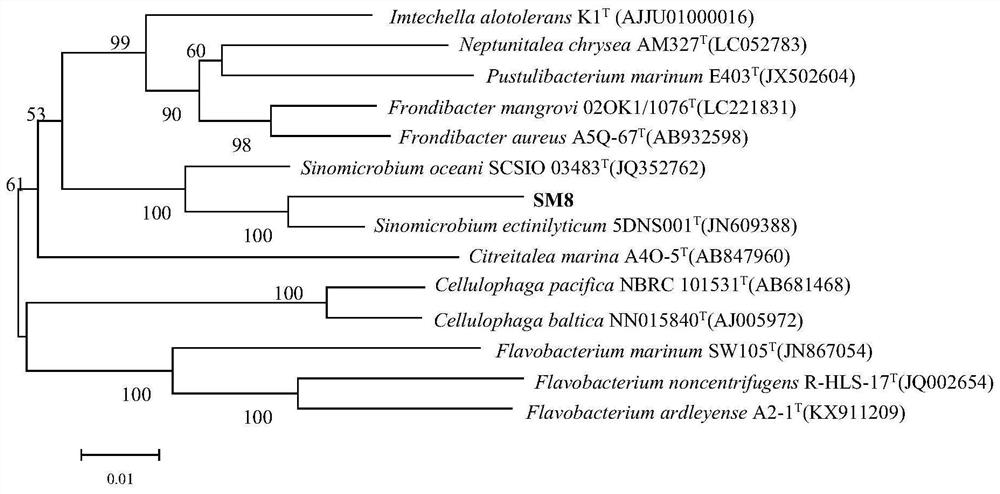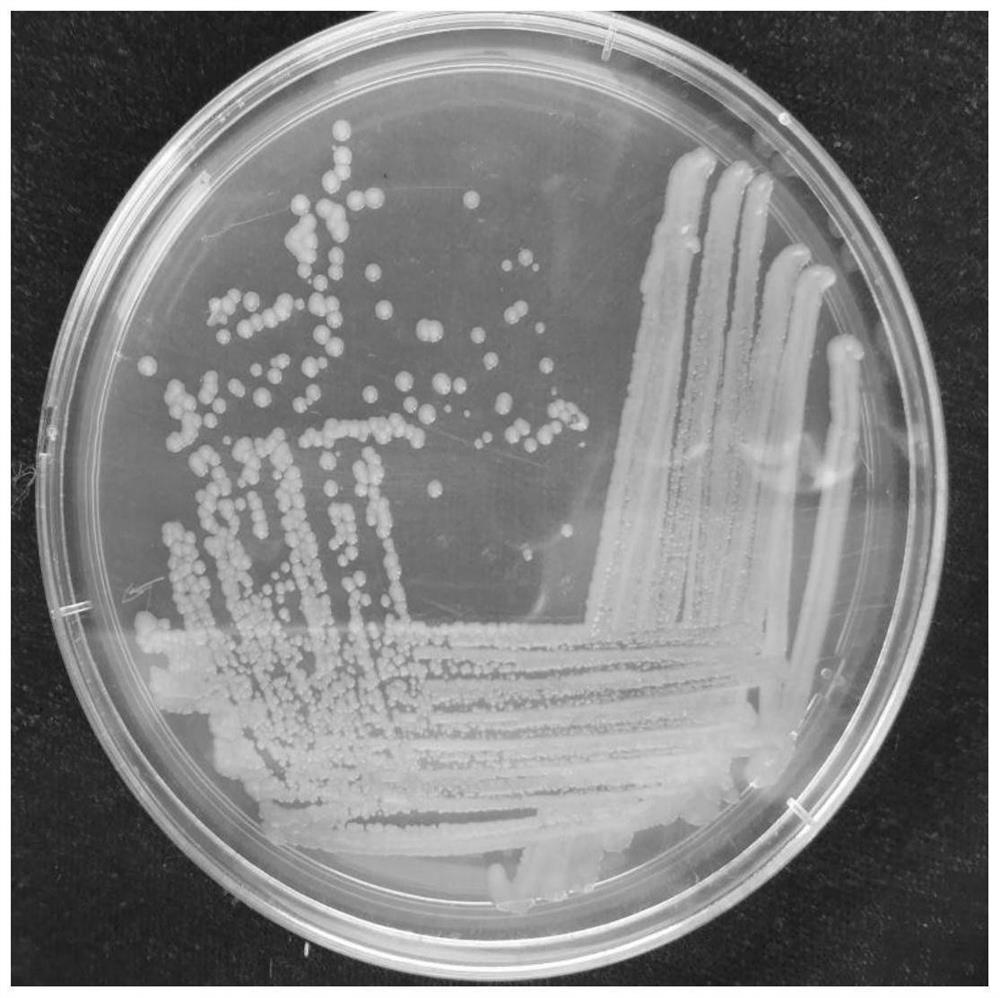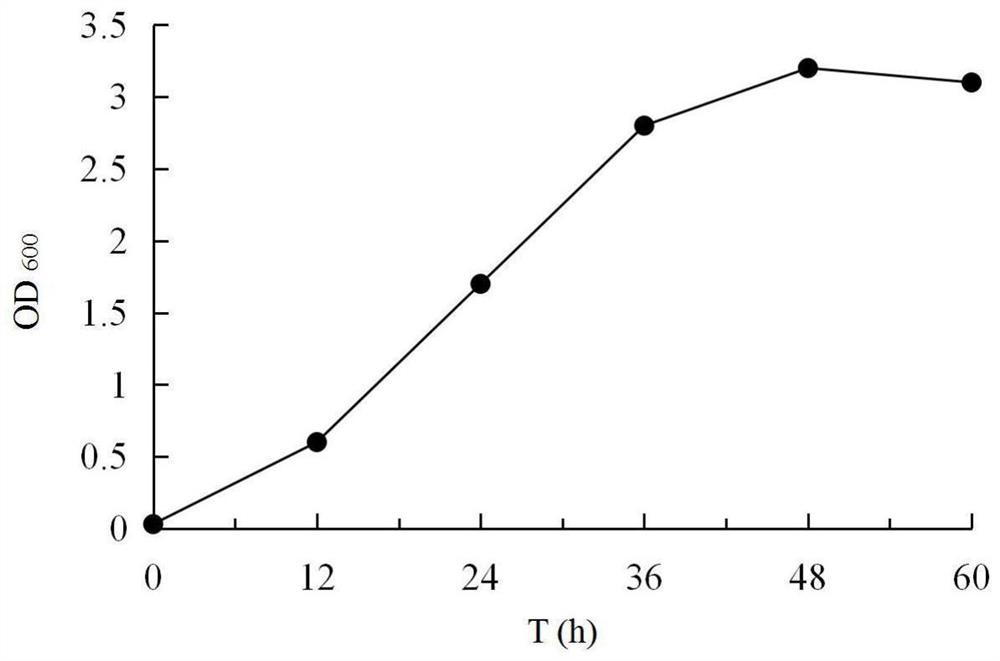A Microbacillus sinensis strain sm8 and its application in salt-tolerant growth promotion
A technology of Microbacterium sinensis and Microbacteria, applied in the direction of microorganism-based methods, applications, microorganisms, etc., can solve the problems of poor adaptability and poor effect of related microorganisms, so as to promote crop growth, increase germination rate and growth rate, and promote significant effect
- Summary
- Abstract
- Description
- Claims
- Application Information
AI Technical Summary
Problems solved by technology
Method used
Image
Examples
Embodiment 1
[0030] Example 1 Isolation, Screening, Purification and Preservation of Microbacillus sinensis SM8 CGMCC No.15757 Strain
[0031] The rhizosphere soil samples of halophytes in Heshuo area of Xinjiang were collected, and the microorganisms were isolated and purified by gradient dilution method. Weigh 10 g of soil sample, put it into 100 ml of sterile water (add glass beads), shake at 200 rpm, 30° C. for 20 min to fully disperse the sample. After serial dilution, dilute with sterile water to prepare 10 -2 -10 -5 sample suspension diluent. Take 100 μL of the dilutions of each concentration, spread them on a TSA solid medium plate containing 2% NaCl by conventional coating method, and place them in a 30° C. constant temperature incubator for cultivation. After 48 hours, after the colonies have grown on the plate, a single colony on the plate is picked for purification and culture. For purified single colonies ( figure 1 ), transferred to the slant of TSA medium containing 2...
Embodiment 2
[0032] Example 2 Identification of Microbacillus sinensis SM8 CGMCC No.15757 strain
[0033] Sequence determination and analysis of 16S rDNA of a new strain of Microbacillus sinensis CGMCC No.15757:
[0034] (1) Extraction of PCR template DNA:
[0035] The purified strain IS7 was inoculated into 2% NaCl TSA medium, cultured on a shaker at 30°C for 2 days, the bacteria were collected, and the total genomic DNA was extracted using a DNA extraction kit.
[0036] (2) PCR amplification
[0037] Use specific primers:
[0038] 27F:5'-AGAGTTTGATCCTGGCTCAG-3',
[0039] 1492R:5'-GGTTACCTTGTTACGACTT-3';
[0040] The total volume of the PCR reaction system was 25 μL, and the PCR amplification conditions were as follows: 94 °C for 5 min; 94 °C for 45 s, 56 °C for 45 s, 72 °C for 45 s, 30 cycles; 72 °C for 10 min.
[0041] (3) Sequence determination
[0042] The PCR amplification product was sequenced after electrophoresis detection and purification, and a 16S r DNA sequence with a le...
Embodiment 3
[0045] Example 3 Detection of salt tolerance and growth-promoting ability of Microbacillus sinensis SM8 CGMCC No.15757 strain
[0046] After adding 10% NaCl to the TSA medium, the plate was poured and inoculated with Microbacillus sinensis SM8 CGMCC No.15757. Incubate at 30°C, and observe the growth of the bacteria for 2-5d.
[0047] Microbacillus sinensis SM8 CGMCC No. 15757 was inoculated on phosphate solubilizing (inorganic phosphorus and organic phosphorus) bacterial medium at 30°C, and the size of the transparent circle was observed after culturing for one week.
[0048] Microbacillus sinensis SM8 CGMCC No. 15757 was inoculated into TSA liquid medium containing L-tryptophan (100mg / L) and 2% NaCl, and after culturing on a shaking table (30°C, 180r / min) for 1 d, 50 μL of bacteria were taken. The suspension was dropped onto a white ceramic plate, and an equal volume of Salkowski colorimetric solution (50 mL of 35% HClO) was added at the same time. 4 +1mL 0.5mol / L FeCl 3 )...
PUM
 Login to View More
Login to View More Abstract
Description
Claims
Application Information
 Login to View More
Login to View More - R&D
- Intellectual Property
- Life Sciences
- Materials
- Tech Scout
- Unparalleled Data Quality
- Higher Quality Content
- 60% Fewer Hallucinations
Browse by: Latest US Patents, China's latest patents, Technical Efficacy Thesaurus, Application Domain, Technology Topic, Popular Technical Reports.
© 2025 PatSnap. All rights reserved.Legal|Privacy policy|Modern Slavery Act Transparency Statement|Sitemap|About US| Contact US: help@patsnap.com



